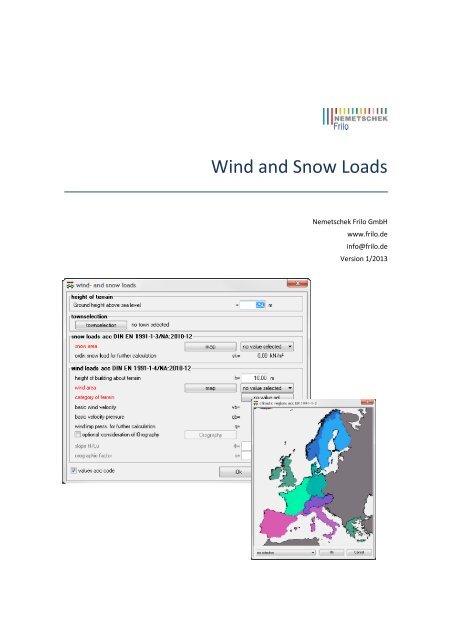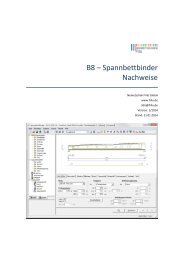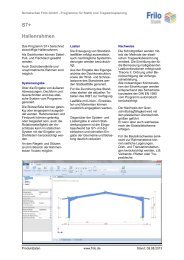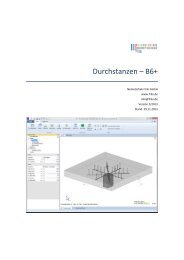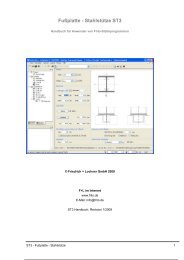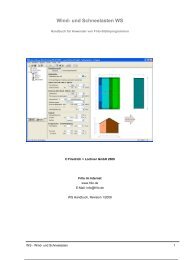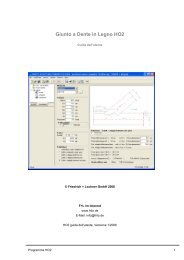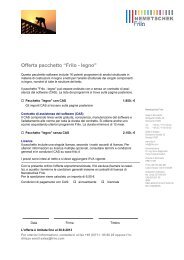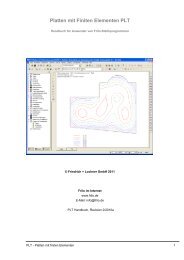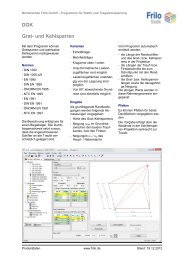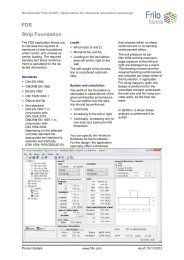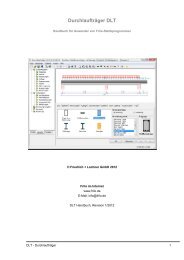Wind and Snow Loads - Frilo
Wind and Snow Loads - Frilo
Wind and Snow Loads - Frilo
You also want an ePaper? Increase the reach of your titles
YUMPU automatically turns print PDFs into web optimized ePapers that Google loves.
<strong>Wind</strong> <strong>and</strong> <strong>Snow</strong> <strong>Loads</strong><br />
Nemetschek <strong>Frilo</strong> GmbH<br />
www.frilo.de<br />
info@frilo.de<br />
Version 1/2013
<strong>Wind</strong>- <strong>and</strong> snow loads<br />
<strong>Wind</strong> <strong>and</strong> <strong>Snow</strong> <strong>Loads</strong><br />
The information in this documents supplements the documentation of our Roof <strong>and</strong> ST7 software<br />
applications.<br />
Note: The present document describes the Eurocode-specific application. Documentation<br />
referring to former st<strong>and</strong>ards is available in our document archive at www.frilo.eu<br />
>>Service >> Documentation >>Manuals.<br />
Contents<br />
<strong>Wind</strong> <strong>and</strong> snow loads 4<br />
EN 1991-1 5<br />
DIN EN 1991-1/NA 7<br />
ÖNORM B 1991-1 8<br />
NA to BS EN 1991-1 9<br />
Nemetschek <strong>Frilo</strong> GmbH Page 3
<strong>Wind</strong> <strong>and</strong> snow loads<br />
This dialog allows you to define impounding wind pressure or velocity pressure <strong>and</strong> regular or ground<br />
snow loads in accordance with the semi-probabilistic safety concept.<br />
The following st<strong>and</strong>ards are currently implemented:<br />
- EN 1991-1-1:2002, EN 1991-1-3:2003, EN 1991-1-4:2005/AC:2009<br />
- EN 1991-1-1:2010-12, EN 1991-1-3:2010-12, EN 1991-1-4:2010-12<br />
- DIN EN 1991-1-1/NA:2009-02, DIN EN 1991-1-3/NA:2007-04, DIN EN 1991-1-4/NA:2008-09<br />
- DIN EN 1991-1-1/NA:2010-12, DIN EN 1991-1-3/NA:2010-12, DIN EN 1991-1-4/NA:2010-12<br />
- ÖNORM B 1991-1-1:2006-01, ÖNORM B 1991-1-3:2006-04, ÖNORM B 1991-1-4:2009-04<br />
- NA to BS EN 1991-1-1:2002, NA to BS EN 1991-1-3:2003, NA to BS EN 1991-1-4:2005<br />
- NTC 3.1, NTC 3.3, NTC 3.4<br />
as well as<br />
- DIN 1055-3:1971-07, DIN 1055-4-A1:1987-06, DIN 1055-5-A1:1994-04<br />
- DIN 1055-3:2006-03, DIN 1055-4:2006-03, DIN 1055-5:2005-07<br />
- see also the documentation in our archive at www.frilo.eu<br />
In order to ease the increased workload involved in the determination of the basic loads in accordance<br />
with the Eurocode, additional input windows are implemented to support the user in this task.<br />
As before, you can enter the basic loads manually, if suitable maps or tables are not available for this<br />
building.<br />
Up-to-date tables about the assignment of communities to wind <strong>and</strong> snow zones are available on the<br />
internet site of the German Competence Center in Civil Engineering DIBT (www.dibt.de, News section).<br />
The governmental lists applicable in the respective country or federal state are always legally binding,<br />
not the lists issued by Institutes such as the DIBt.<br />
In the case of doubt, you should always check the list applicable in the respective country or federal<br />
state.<br />
<strong>Wind</strong>- <strong>and</strong> snow loads<br />
Page 4 Software for structural calculation <strong>and</strong> design
<strong>Wind</strong>- <strong>and</strong> snow loads<br />
EN 1991-1<br />
<strong>Snow</strong> loads as per EN 1991-1-3:2010-12<br />
Alternatively to EN 1991-1-3:2010-1, you can still select the former DIN EN 1991-1-3:2004 to check older<br />
items.<br />
The regular snow load is determined in dependence of the altitude in the respective snow zone.<br />
Depending on the selected climatic region, different snow zone maps are available:<br />
In the associated software applications, the roof snow load si can be calculated with the help of the<br />
regular snow load sk as follows:<br />
Roof snow load si =mi◊ sk<br />
2<br />
i<br />
s<br />
<strong>Snow</strong> load on the eaves Se= k◊<br />
g<br />
Values as per st<strong>and</strong>ard if you uncheck this option, you can specify a user-defined value for the<br />
regular snow load sk. Keep in mind that increased values may apply in some<br />
areas of zone 3.<br />
<strong>Wind</strong> loads as per EN 1991-1-4:2010-12<br />
Alternatively to EN 04/01/1991:2010-12, you can still select the<br />
former DIN EN 04/01/1991:2005 to check older projects.<br />
The velocity pressure is calculated with consideration to the<br />
topographical border conditions.<br />
In addition to the terrain categories, various coefficients such as<br />
the directional factor, the season coefficient or topographic<br />
influence due to exposed locations or shadow effects can<br />
optionally be taken into account.<br />
Nemetschek <strong>Frilo</strong> GmbH Page 5
The velocity pressure q is determined for the maximum building height z in accordance with EN 1991-1-<br />
4, 4.<br />
In the associated software applications, the wind load we can be calculated with the help of the velocity<br />
pressure q as follows:<br />
<strong>Wind</strong> load we = cpe◊ q<br />
with the aerodynamic coefficients cpe as per EN 1991-1-4, 7.2<br />
Values as per st<strong>and</strong>ard if you uncheck this option, you can specify a user-defined value for the<br />
velocity pressure, if you want to calculate a building in an exposed location<br />
for instance.<br />
<strong>Wind</strong>- <strong>and</strong> snow loads<br />
Page 6 Software for structural calculation <strong>and</strong> design
<strong>Wind</strong>- <strong>and</strong> snow loads<br />
DIN EN 1991-1/NA<br />
<strong>Snow</strong> loads as per DIN EN 1991-1-3/NA:2010-12<br />
Alternatively to DIN EN 1991-1-3/NA:2010-12, you can still select the former DIN EN 1991-1-3/NA:2007-<br />
04 to check older projects.<br />
DIN EN uses its own division of snow load zones together with its own formula for the calculation of the<br />
soil snow load sk.<br />
You can also use the "Community selection” function to determine the snow zone:<br />
In the associated software applications, the roof snow load si can be calculated with the help of the<br />
regular snow load sk as follows:<br />
Roof snow load si =mi◊ sk,<br />
Attention! DIN EN uses partly a different i!<br />
<strong>Snow</strong> load on the eaves<br />
2<br />
si<br />
Se= k◊<br />
with k=0.4 or k=0 if snow guards are fitted<br />
g<br />
Values as per st<strong>and</strong>ard if you uncheck this option, you can specify a user-defined value for the<br />
regular snow load sk. Keep in mind that increased values may apply in some<br />
areas of zone 3.<br />
<strong>Snow</strong> loads as per DIN EN 1991-1-4/NA:2010-12<br />
Alternatively to DIN EN 1991-1-4/NA:2010-12, you can still select the former DIN EN 1991-1-4/NA:2008-<br />
09 to check older projects.<br />
The velocity pressure is determined in accordance with DIN EN 1991-1-4/NA, 4.2 or Annex NA.A <strong>and</strong><br />
depends on the topographic border conditions.<br />
The directional factor <strong>and</strong> the season coefficient are included with a value of 1.0 as defined by DIN EN<br />
1991-1-4/NA, 4.2.<br />
The wind <strong>and</strong> snow zones are determined with the help of the selection of the community in<br />
accordance with the list issued by the German Competence Center in Civil Engineering DIBt.<br />
The velocity pressure q is determined for the maximum building height z.<br />
In the associated software applications, the wind load we can be calculated with the help of the velocity<br />
pressure q as follows:<br />
<strong>Wind</strong> load we = cpe◊ q<br />
with the aerodynamic coefficients cpe as per DIN EN 1991-1-4/NA, 7<br />
Values as per st<strong>and</strong>ard if you uncheck this option, you can specify a user-defined value for the<br />
velocity pressure, if you want to calculate a building in an exposed location<br />
for instance.<br />
Nemetschek <strong>Frilo</strong> GmbH Page 7
ÖNORM B 1991-1<br />
<strong>Snow</strong> loads as per ÖNORM B 1991-1-3:2006-04<br />
ÖNORM st<strong>and</strong>ards use their own division of snow load zones together with their own formula for the<br />
calculation of the soil snow load sk.<br />
For particular communities listed in the Annex to ÖNORM, snow <strong>and</strong> wind loads can also be determined<br />
by selecting a community.<br />
Selection from the ZAMG list<br />
Alternatively, you can select the zones from a list issued by the central Austrian office for meteorology &<br />
geodynamics (ZMAG).<br />
In the associated software applications, the roof snow load si can be calculated with the help of the<br />
regular snow load sk as follows:<br />
Roof snow load si =mi◊ sk,<br />
Attention! ÖNORM uses it own i!<br />
<strong>Snow</strong> load on the eaves Se = 0,5◊ si<br />
Values as per st<strong>and</strong>ard if you uncheck this option, you can specify a user-defined value for the<br />
regular snow load sk. Keep in mind that increased values may apply in some<br />
areas of zone 3.<br />
<strong>Wind</strong> loads as per ÖNORM B 1991-1-4:2009-04<br />
The velocity pressure is determined in accordance with ÖNORM B 191-1-4, 4.2 <strong>and</strong> depends on the<br />
topographic border conditions.<br />
The directional factor <strong>and</strong> the season coefficient are included with a value of 1.0 as defined by ÖNORM<br />
B 1991-1-4, 4.2.2.<br />
The velocity pressure q is determined for the maximum building height z in accordance with ÖNORM B<br />
1991-1-4, 4.2.<br />
In the associated software applications, the wind load we can be calculated with the help of the velocity<br />
pressure q as follows:<br />
<strong>Wind</strong> load we = cpe◊ q<br />
with the aerodynamic coefficients cpe as per ÖNORM B 1991-1-4, 4.6.<br />
Values as per st<strong>and</strong>ard if you uncheck this option, you can specify a user-defined value for the<br />
velocity pressure, if you want to calculate a building in an exposed location<br />
for instance.<br />
<strong>Wind</strong>- <strong>and</strong> snow loads<br />
Page 8 Software for structural calculation <strong>and</strong> design
<strong>Wind</strong>- <strong>and</strong> snow loads<br />
NA to BS EN 1991-1<br />
<strong>Snow</strong> loads as per NA to BS EN 1991-1-3:2003<br />
NA to BS EN 1991-1-3 uses its own division of snow load zones (Figure NA.1) together with its own<br />
formula for the calculation of the soil snow load sk.<br />
In the associated software applications, the roof snow load si can be calculated with the help of the<br />
regular snow load sk as follows:<br />
Roof snow load si =mi◊ sk,<br />
Attention! NA to BS EN uses its own i!<br />
<strong>Snow</strong> load on the eaves e<br />
2<br />
si<br />
S = g<br />
Values as per st<strong>and</strong>ard if you uncheck this option, you can specify a user-defined value for the<br />
regular snow load sk. Keep in mind that increased values may apply in some<br />
areas of zone 3.<br />
<strong>Wind</strong> loads as per NA to BS EN 1991-1-4:2005<br />
The velocity pressure is determined in accordance with NA to BS EN 1991-1-4, NA 2.17 <strong>and</strong> depends on<br />
the topographic border conditions.<br />
The United Kingdom uses its own wind zones <strong>and</strong> the coefficients depend on the distance to the sea<br />
shore or the border of the town or village.<br />
The velocity pressure q is determined for the maximum building height z in accordance with NA to BS EN<br />
1991-1-4, NA.2.17.<br />
In the associated software applications, the wind load we can be calculated with the help of the velocity<br />
pressure q as follows:<br />
<strong>Wind</strong> load we = cpe◊ q<br />
with the aerodynamic coefficients cpe as per NA to BS EN 1991-1-4, NA.2.29.<br />
Values as per st<strong>and</strong>ard if you uncheck this option, you can specify a user-defined value for the<br />
velocity pressure, if you want to calculate a building in an exposed location<br />
for instance.<br />
Nemetschek <strong>Frilo</strong> GmbH Page 9


